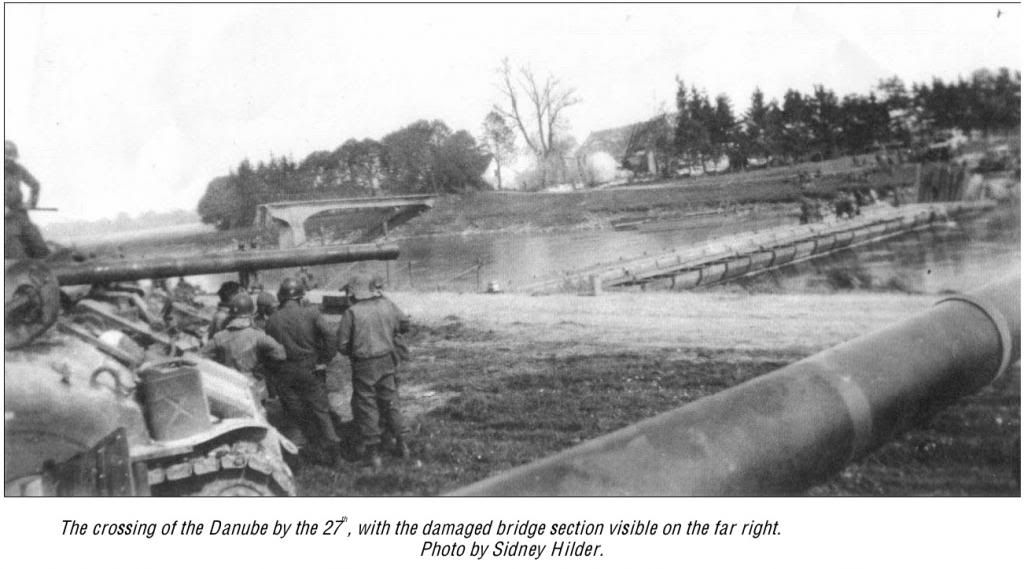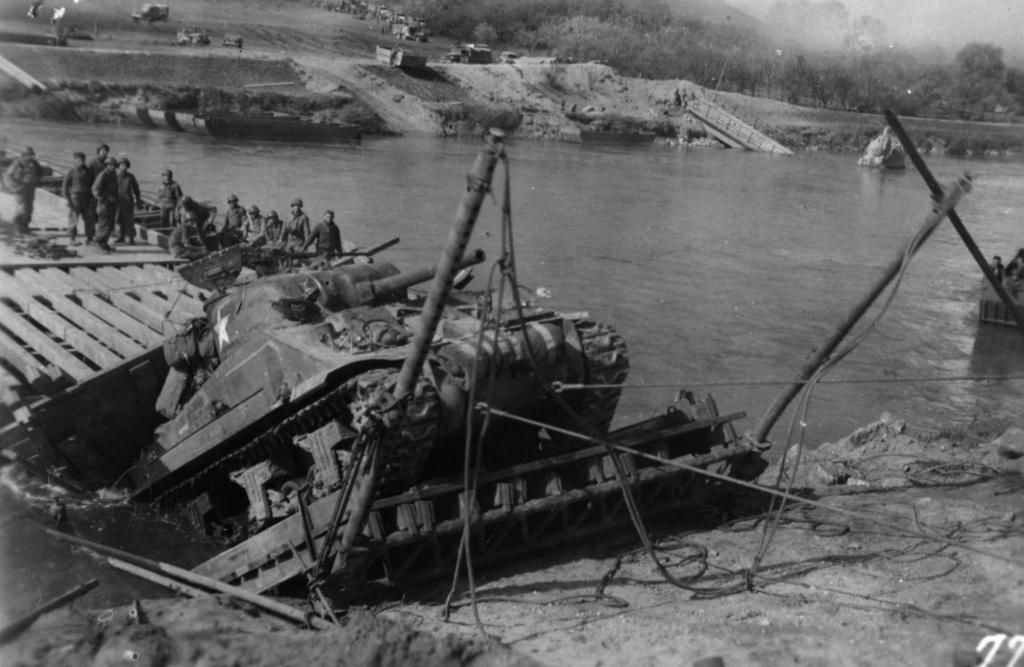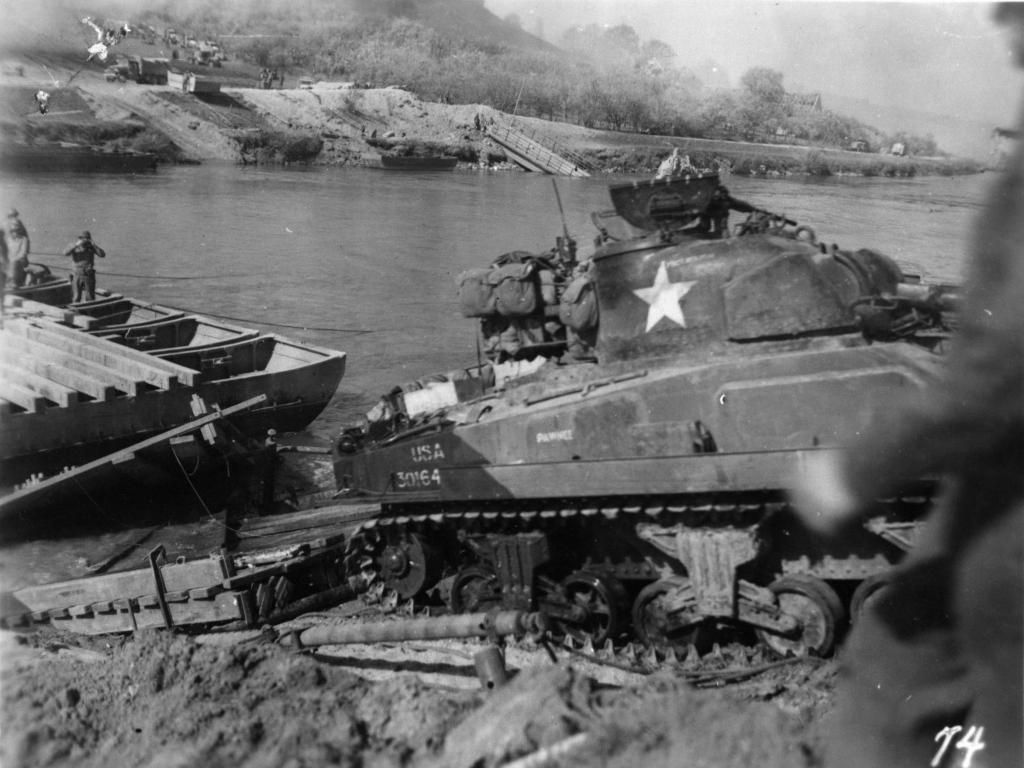brian m
In talking with my 157th veteran friends, I have heard about the tank that took a dip at the end of the treadway bridge that the 157th built on the Danube River, and when I bring out the photo they remember it even more so.
I have wondered what outfit the tank came from and exactly what happened. I had some some clues like the tanks name "Pawnee", but I could not track anything down. Well, the other day I saw a yearbook for the 20th Armored Division and it mentioned their crossing the Danube and I went searching for where they went across. When I saw that it was the area where the 157th bridge was, I contacted the 20th Armored Division Association and they quickly responded with the following!
From the division's history book: "Early on the 26th, infantrymen from the 232nd and 242nd, and Engineers from the 109th and 142nd, made river crossings about 0300, with the infantry pushing on and the engineers starting construction of a treadway bridge across the river. At about 1430 on the afternoon of the 26th, three First Platoon tanks of ‘C’ Company were the first to cross the bridge under artillery fire that rained shrapnel from overhead. The lead tank was named “Pawnee” and was commanded by Sergeant Ralph E. Bowman, with gunner Sidney R. Hilder (Evanston, Illinois), bow gunner Frederick C. Limmer (Virginia, Minnesota), and driver T/4 John W. Nairn (Pawnee Rock, Kansas). Interestingly enough, the tank’s loader was Private First Class Cyril O. ‘Cy’ Whatcott (Ogden, Utah), who had been the gunner in a tank that had been knocked out in Berg the day before -- the tank commanded by Second Lieutenant William Grimes, Jr.
The steel tracks of the bridge were supported by aluminum shell boats, which in turn were held together by heavy steel cables, one on each side. The steel cables were anchored on both sides of the river to a large steel post welded to a heavy steel plate for its base. The steel cables ran over the top of the posts, and the far side of the river had a sharp incline that had been graded by the engineers. When ‘Pawnee’ started over the last section of the bridge, the posts sunk into the ground and the cables went slack. Nairn noticed that the weight of his tank began to pull the first section of the pontoon bridge away from the embankment. The rear of the tank dropped sharply into the river, and Nairn immediately locked the brakes. Even though he couldn’t swim and was “hanging on for dear life,” T/4 Nairn stayed with the tank as the rest of the crew scrambled out and jumped on shore. Another tank was on shore waiting to cross and was directed to move upstream a short distance. “Pinto” was the tank commanded by Sergeant William P. ‘Bill’ Schmidt with driver Robert H. ‘Bob’ Eilola (Virginia, Minnesota), gunner Gilbert J. ‘Bill’ Schlagel (St. Paul, Minnesota), loader Thomas J. Kingsley (Owatonna, Minnesota), and bow gunner Donald B. Jones (Torrance, California). The engineers directed them to drive onto a pontoon in order to pull them across by cable and winch.The dismount on the other side was made by slamming the clutch in and lurching up the bank, leaving the depths of the “Blue Danube” behind. Pinto’s crew laughed at the fact that they had been the first to cross -- without using a bridge! They proceeded back downstream to where T/4 Nairn was still hanging on with “Pawnee.” He dismounted, and under sporadic enemy fire, secured a cable from Pinto, which acted as a prime-mover and assisted in pulling his tank out. His quick action saved the tank and kept the bridge from collapsing completely, but Pawnee’s engine needed to be replaced. T/4 Nairn was awarded the Bronze Star.
What more could you ask for??? I still want to see if any of the crew is still around so I can send some photographs. How cool would that be to see your tank in the Danube this many years off!


157th Engineer Combat Battalion Photograph

157th Engineer Combat Battalion Photograph